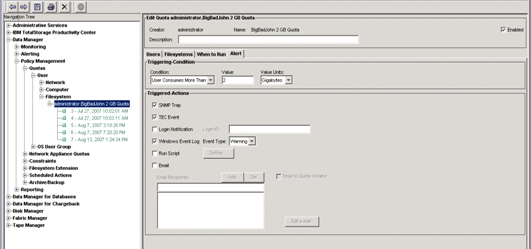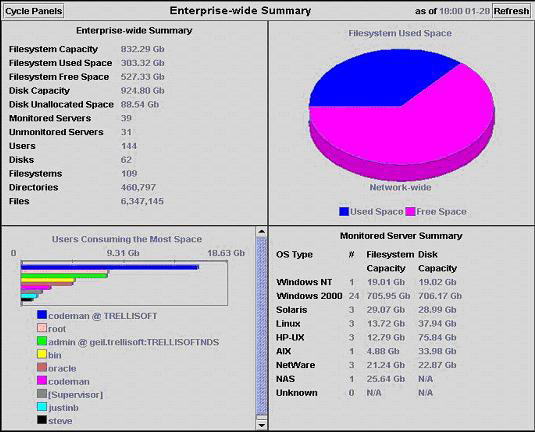| Tool Mentor: TPC – Monitor and Report Data Management Operations |
 |
|
| Related Elements |
|---|
ContextTool mentors explain how a tool can perform tasks, which are part of ITUP processes and activities. The tasks are listed as Related Elements in the Relationships section. You can see the details of how processes and activities are supported by this tool mentor, by clicking the links next to the icons: DetailsA typical approach to managing storage resources involves manual processes and custom scripts. For every platform, there might be a custom script to list the storage that is available on individual servers. The storage administrators who manage these scripts must run them periodically, but generally do not have the time to analyze the results and, therefore, sometimes miss critical situations. To find stale, duplicate, or inappropriate files, the storage administrators would need to have write access to all the servers in the environment. They would also need to write custom scripts, debug them, run them regularly, and review the resulting information manually. They would then need to try to act on issues, while trying to perform normal duties. The scripts also have to be maintained so that they cater to new servers, new LUNs or volumes, new filesystems, new applications, new policies, and so on. Doing all this manually is very difficult, if not almost impossible. IBM® TotalStorage® Productivity Center (TPC) for Data provides over 300 enterprise-wide reports, monitoring and alerts, policy-based action, and file system capacity automation in heterogeneous environments. TPC for Data helps you discover, monitor, and create enterprise policies for your disks, storage volumes, file systems, files, and databases. You will find where all your storage is located and place yourself in a better position to act intelligently on this information. Application availability is improved because you will have early warnings when file systems are running out of space and have the ability to provision more disk space automatically. If you are thinking about server consolidation, you can use TPC for Data to help efficiently utilize your accumulated storage resources. Architected for efficiency and ease-of-use, TPC for Data uses a single agent per server to provide detailed information without high consumption of network bandwidth or CPU cycles. Through monitoring, analyzing, and reporting, TPc for Data helps the storage administrator prevent outages in the storage infrastructure. Armed with timely information, the storage administrator can take action to keep storage and data available to the application. TPC for Data also helps to make the most efficient use of storage budgets by allowing administrators to use their existing storage more efficiently, and more accurately predict future storage growth. When TPC for Data is installed, it can be configured to define and enforce storage policies through user-defined alerts, quotas, and constraints, notifying the user by e-mail, pager, the event log, or a systems management console for events such as when a quota has been exceeded or a constraint violated. However, finding a problem is not enough. You also need a way to find and fix problems, or potential problems, as they are discovered.
TPC for Data can provide automated solutions through event management. Alerts, quotas that have been exceeded, or constraints that have been violated can result in notification or action, enabling the user to fix or even prevent storage outages. For example, if TPC for Data discovers data that has not been accessed in more than a year, it can trigger Tivoli® Storage Manager or another archive utility. This figure of a dashboard provides a concise, yet detailed overview of the health of your storage environment. It enables you to quickly point out potential problem areas that need further investigation.
TPC for Data gathers and reports on disk subsystems. Information includes physical characteristics such as the drive's manufacturer, model, serial number, capacity, and rotational speed. Also included is how the drive's storage is allocated to logical volumes, snapshot copy volumes, and free space. This feature allows users to perform several actions(subject to a vendor implementation of Storage Management Initiative - Specification [SMI-S]):
In summary, the primary business purpose of TPC for Data is to help the storage administrator keep data available to applications. Through monitoring and reporting, TPC for Data helps the storage administrator prevent outages in the storage infrastructure. Armed with timely information, the storage administrator can take action to keep storage and data available to the application. TPC for Data allows administrators to use their existing storage more efficiently, and more accurately predict future storage growth. For more informationFor more information about this tool, go to the IBM TotalStorage Productivity Center page. |
©Copyright IBM Corp. 2005, 2008. All Rights Reserved. |

